The ongoing drone war between the United States and China has taken to the skies, focusing on the growing use and control of drones. Drones, or unmanned aerial vehicles (UAVs), are being widely used for both civilian and military purposes. However, the United States and China are now clashing over how these devices should be managed and controlled, with each country taking steps to limit the other’s influence in this critical technology.
Rising Tensions Over Drone War
Recently, China announced new rules that would tighten the export of drones and their parts, especially those that could be used for military purposes. Starting September 1, Chinese companies will be banned from exporting certain drone components without special permission from the government. This includes high-powered engines, infrared cameras, and other equipment that could easily be used in warfare. The goal is to prevent these technologies from being used in conflicts around the world, but it also serves to protect China’s national security and maintain control over its advanced technology.
At the same time, the United States has accused China of providing key drone components to countries like Russia and Iran, which are under heavy sanctions. The US and its allies believe that Chinese-made drones and parts are helping these nations build up their military capabilities, which could threaten global stability. As a result, the US has imposed sanctions on several Chinese companies and individuals involved in the drone industry, further escalating the tech war between the two superpowers.
US Strikes Back with Sanctions
In response to China’s growing drone capabilities, the United States has taken several steps to counter what it sees as a threat. The US government has passed laws to restrict the use of Chinese-made drones within its borders, especially those made by DJI, a leading Chinese drone manufacturer. These restrictions are part of a broader effort to curb China’s influence in the tech industry, particularly in areas that could impact national security.
China’s Veiled Warning to US; Threat Looms Over $3.6 Billion Chancay Port
The US has also been actively working with its allies to limit China’s access to advanced technology that could be used in drones. This includes cutting off supplies of critical components like semiconductors, which are essential for drone operations. By doing so, the US hopes to slow down China’s progress in developing more advanced UAVs and prevent these technologies from falling into the hands of countries that could use them for military purposes. However these activities trigger drone war.
Additionally, the US has been targeting Chinese companies that are believed to be supplying drones and drone parts to countries like Russia and Iran. These nations have been using drones in conflicts, including in Ukraine and the Middle East, which has raised concerns about the proliferation of drone technology. The US Treasury Department has added several Chinese companies to its sanctions list, accusing them of supporting these nations’ military programs. Iran Warns Jordan Over the Intercepted Drones Bound for Israel
The Global Impact of the Drone War
The clash between the US and China over drones is not just about technology; it has broader implications for global security and trade. Drones are becoming increasingly important in both civilian and military applications, from agriculture and filmmaking to surveillance and warfare. As these devices become more advanced and widely available, the risk of them being used in drone war around the world is growing.
China is one of the world’s largest producers of drones, and its UAVs are used by countries around the globe. However, as tensions with the US rise, China’s drone exports are coming under greater scrutiny. The new export controls are a response to pressure from the US and its allies, who are concerned that Chinese-made drones could be used in ways that threaten international peace and security. The Power Struggle Over US Espionage Drones in the Black Sea Escalates Geopolitical Tensions
At the same time, the US is trying to limit China’s access to key technologies that could be used in drones. This includes imposing sanctions on Chinese companies and individuals, as well as restricting the export of critical components to China. These measures are part of a broader strategy to contain China’s rise as a global tech power and maintain the US’s dominance in the field.
As the US and China continue drone war in the skies, other countries are being caught in the crossfire. Nations that rely on Chinese-made drones for civilian purposes, such as agriculture or infrastructure development, may find it harder to access these technologies. Meanwhile, countries that are sanctioned by the US may turn to China for drone supplies, further complicating the geopolitical landscape.
In conclusion, the US-China drone war is a key battleground in the broader tech war between the two superpowers. As both sides continue to tighten their controls on drone technology, the impact will be felt not just by the companies involved, but by countries and industries around the world. The battle for dominance in the skies is only just beginning, and its outcome could shape the future of global security and trade for years to come.



